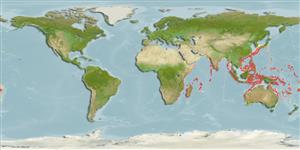Common names from other countries
Environment: milieu / climate zone / depth range / distribution range
Ecologia
marinhas demersal; intervalo de profundidade 150 - 278 m (Ref. 44037). Deep-water
Indo-West Pacific: including Japan.
Tamanho / Peso / Idade
Maturity: Lm ? range ? - ? cm
Max length : 11.4 cm SL macho/indeterminado; (Ref. 11148)
Espinhos dorsais (total) : 0; Raios dorsais moles (total) : 85 - 97; Espinhos anais: 0; Raios anais moles: 71 - 81; Vértebras: 40 - 42. Pelvic fin on ocular side slightly elongate, extending to near the tip of the isthmus, the distance between the tip of the isthmus and the insertion of the pelvic fine subequal to the length of the pelvic fin base. Second ray of the pelvic fin on ocular side opposite to the 1st on the blind side. In male, the 12th to 18th dorsal rays and the 1st to 8th anal rays greatly elongated into filaments (Ref. 559). Soft ray count of pectoral fin refers to that on ocular side.
Life cycle and mating behavior
Maturities | Reprodução | Spawnings | Egg(s) | Fecundities | Larvas
Masuda, H., K. Amaoka, C. Araga, T. Uyeno and T. Yoshino, 1984. The fishes of the Japanese Archipelago. Vol. 1. Tokai University Press, Tokyo, Japan. 437 p. (text). (Ref. 559)
Categoria na Lista Vermelha da IUCN (Ref. 130435)
CITES (Ref. 128078)
Not Evaluated
Ameaça para o homem
Harmless
Utilização humana
Ferramentas
Relatórios especiais
Descarregue XML
Fontes da internet
Estimates based on models
Preferred temperature (Ref.
115969): 13.8 - 21.4, mean 16.9 (based on 86 cells).
Phylogenetic diversity index (Ref.
82804): PD
50 = 0.7500 [Uniqueness, from 0.5 = low to 2.0 = high].
Bayesian length-weight: a=0.00912 (0.00408 - 0.02036), b=3.05 (2.87 - 3.23), in cm Total Length, based on LWR estimates for this (Sub)family-body shape (Ref.
93245).
Nível Trófico (Ref.
69278): 3.5 ±0.4 se; based on size and trophs of closest relatives
Resiliência (Ref.
120179): Médio, tempo mínimo de duplicação da população 1,4 - 4,4 anos (Preliminary K or Fecundity.).
Fishing Vulnerability (Ref.
59153): Low vulnerability (10 of 100).
